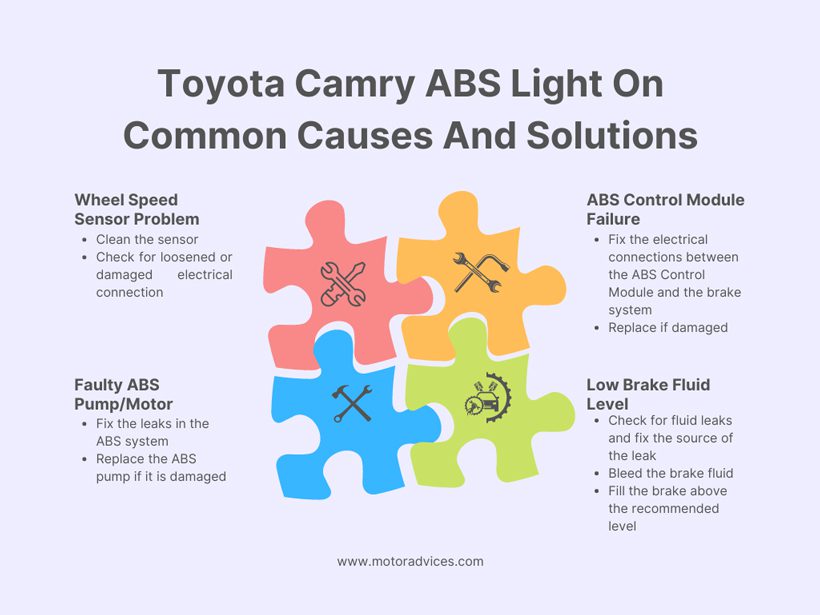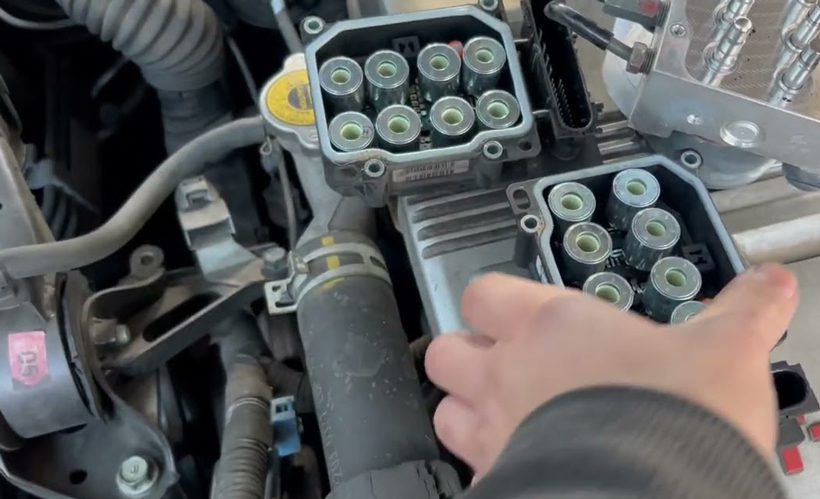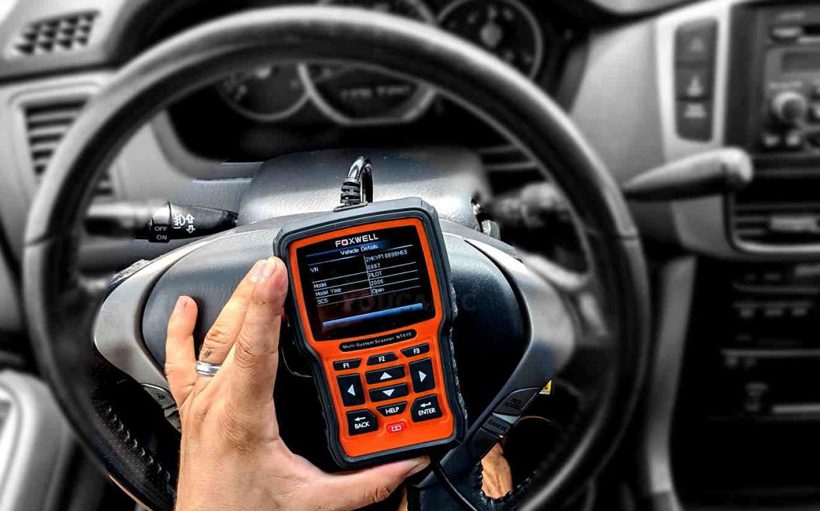Toyota Camry ABS Light On: Common Causes and Resetting Solutions
Modern automobiles must include the Anti-lock Braking System (ABS), and the Toyota Camry is no exception. However, some users come across unexpected ABS light on, which makes them worry.
So why is the Toyota Camry ABS Light On? The ABS light in a Camry may come on due to issues like faulty wheel speed sensors, ABS control module failure, or low brake fluid, etc. It takes sophisticated equipment and a qualified diagnostic to reset the ABS light.
In this article, we examine the frequent reasons why the Toyota Camry ABS light illuminates and offers practical reset options. Moreover, we’ll look at the ABS’s essential parts and discuss any potential issues. So let’s get started.
Table: Toyota Camry ABS Light On Common Causes And Solutions

Before we dig in deep with the problems and fixes, let’s check out some quick fixes that you can apply first.
| Cause | Quick Fix |
|---|---|
| Wheel Speed Sensor Problem | Clean the sensor |
| Check for loosened or damaged electrical connection | |
| ABS Control Module Failure | Fix the electrical connections between the ABS Control Module and the brake system |
| Replace if damaged | |
| Faulty ABS Pump/Motor | Fix the leaks in the ABS system |
| Replace the ABS pump if it is damaged | |
| Low Brake Fluid Level | Check for fluid leaks and fix the source of the leak |
| Bleed the brake fluid | |
| Fill the brake above the recommended level |
In-Depth: Common Causes And Solutions for Toyota Camry ABS Light On
The processes to identify the issue and practical methods for turning off the ABS warning light are covered in the subsections.

Wheel Speed Sensor Problem
The ABS’s wheel speed sensors are essential parts. They are often found inside the wheel bearing assembly or close to each wheel’s hub. These sensors transmit data to the ABS control module on the rotational speed of each wheel continuously.
Many issues, such as accumulated dirt, debris, or brake dust on the sensor surface, could damage wheel speed sensors. Also, loose or damaged electrical connections can disrupt the sensor’s communication with the ABS module.

Solution
Here’s how to solve it:
- Inspect and Clean: Check for dust, debris, or brake dust on the wheel speed sensors and clean them.
- Check Connections: Make sure the sensors’ electrical connections are solid and unharmed.
- Reset ABS Light: To reset the ABS warning light, use a diagnostic tool or OBD-II scanner. We have covered resetting the ABS light in the next section. You can follow the steps from there.
- Test Drive: Drive the car to see if the ABS light stays off and the system operates smoothly. You can run the test for about 15-20 minutes at low speeds.
ABS Control Module Failure
The ABS control module is the brain of the ABS. It decides when to turn on the ABS to avoid wheel lock-up after receiving data from a variety of sensors, including the wheel speed sensors.
Electrical problems, water damage, or simply general wear and tear over time can cause control module failure. In rare circumstances, a damaged ABS pump or motor might potentially harm the control module.

Solution
Here’s the solution you can follow:
- Check Connections: Make sure the electrical connections between the ABS Control Module and the brake system are secure.
- Dry Out Water Damage: Address water damage and corrosion in the ABS Control Module and wirings.
- Reset ABS Light: Use a diagnostic tool to reset the ABS warning light. We have covered how to do it in the later section of this article.
- Replace Control Module: If the ABS control module is broken beyond repair, think about replacing it. You can confirm it’s beyond repair by visual inspection. Look for serious physical damage, excessive heating, and water intrusion. If present, it needs to be replaced.
Faulty ABS Pump/Motor
Over time, wear and tear on the ABS pump/motor may cause a decline in performance. External elements like leaks or contaminants might also reduce the effectiveness of the pump.
An inoperable ABS pump or motor may not produce the pressure necessary to effectively activate the ABS. Thus, the ABS warning light may come on, alerting the driver to a potential problem with the pump/motor unit.

Solution
Follow the processes to solve the issues:
- Examine for Leaks: Check the ABS for leaks and make any required repairs.
- Evaluate Performance: Check to see if pressure generation by the pump and motor is impacted by wear and tear. If the pressure generation is faulty, use the OBD-II port to know about the underlying problems. Fix those individual problems and bleed the brakes.
- Replace: If the pressure doesn’t get back to normal after fixing the underlying issues, consider replacing the faulty pump/motor.
- Replacement Process: Disconnect the battery first, drain the brake fluid, disconnect the brake lines from the pump, and remove any bolt holding the ABS pump. Place the new ABS pump in the same position and connect the bolts as well as the brake line and battery.
Low Brake Fluid Level
Brake fluid leaks, worn brake pads, or regular wear and tear over time can cause low brake fluid levels.
The ABS module may detect a possible loss of hydraulic pressure in the system when the brake fluid level falls below a certain threshold. As a result, the driver is warned by the ABS warning light that there may be a problem with the brake fluid level.

Solution
Here’s how to solve it:
- Check for leaks: Check for brake fluid leaks by visually inspecting any leaked fluid around the brake system components, brake lines, calipers, and wheel cylinders.
- Replacement of faulty parts: Once you have found where the leak is, replace the faulty components. It might be the calipers, master cylinders, or wheel cylinders. If it’s the brake line, replace the brake line.
- Bleed Brake System: Consider bleeding the brake system to ensure optimal performance. You can locate the bleeder valve on the brake caliper and open it while another person pumps the brake pedal. Repeat the process.
Here’s a video that will help you with the bleeding process;
Resetting the Toyota Camry ABS Light
Resetting the ABS warning light on a Toyota Camry can be achieved through different methods. Let’s check the methods below.

Using the vehicle’s onboard diagnostics (OBD) system
Here’s how you can reset using the OBD system:
- Locate the OBD-II port: On the driver’s side, the OBD-II port is normally located beneath the dashboard. It is a standardized port used to connect diagnostic tools to the vehicle’s computer system.
- Connect the OBD-II scanner: Obtain an OBD-II scanner or code reader, which can be purchased or borrowed from an auto parts store. Plug the scanner into the OBD-II port.
- Read and clear the codes: Turn the ignition on without starting the engine, and follow the instructions provided by the OBD-II scanner to read the ABS trouble codes.
The scanner may allow the user to clear the codes once they have been read, including the ABS code in charge of the warning light.
- Wait for the ABS light to reset: After clearing the ABS code, turn off the ignition, disconnect the scanner, and start the vehicle. If the problem has been correctly reset, the ABS light ought to be off.
Here’s a YouTube video that will help you visualize.
Manual reset options
Here are some manual resetting options:
Disconnecting the battery
Some drivers attempt to reset the ABS light by disconnecting the vehicle’s battery for a few minutes and then reconnecting it. This approach might not always work, and it might also reset other car settings.
Drive cycles
In some cases, the ABS light may reset itself after several successful drive cycles without any issues. Short drives worth 5-10 minutes at a speed below 20 mph should do the trick. You can do the short drives 4-5 times.
If the underlying issue is transient or intermittent, this may occur. However, using this approach exclusively can delay the detection of ongoing problems.
When To Seek Assistance From A Qualified Mechanic?

While a basic visual inspection can offer some clues, it is essential to seek assistance from a qualified mechanic when:
- The ABS warning light remains on: If the ABS warning light persists, it indicates an ongoing issue that requires professional diagnosis to determine the specific cause.
- ABS activation or loss of ABS functionality: If you experience unexpected ABS activation during normal driving conditions or notice that the ABS is not functioning as intended.
- Unusual braking behavior: Any unusual braking behavior, including a spongy brake pedal, pulsing while braking, or prolonged stopping distances.
- Limited DIY knowledge: It is advised to avoid performing complicated repairs on the ABS. Instead, seek expert assistance if you are unfamiliar with automotive systems or lack the necessary diagnostic equipment.
FAQs
Here are some relevant FAQs you might have regarding your Camry ABS lights:
The best way to avoid ABS-related issues is through routine maintenance and upkeep. Follow the suggested maintenance plan provided by the manufacturer, check the brake fluid level often, and inspect the braking system as needed.
The cost of repairing the ABS system is versatile. It can range from $20 to $1500, depending on the fault. If it’s just the wire harness, you can replace it within $20, but you may encounter problems where you need to replace the master cylinder. So it depends entirely on the fault.
If the ABS light re-illuminates after resetting, it indicates the underlying issue is still present. The safety and performance of the ABS may be jeopardized if you keep the ABS light on while driving. Hire a trained technician to help you identify the issue and fix it.
Conclusion
We believe we have covered all you could need to know about the Toyota Camry ABS light on. To sum up, ensure that the brake fluid is above the recommended level, all the wirings are properly working, and the entire ABS system is leak-free. Moreover, the ABS pump is pumping enough pressure.
Lastly, the ABS Control Module is the most important part. Visually inspect for any signs of corrosion or water damage and replace anything that’s damaged. Resetting the ABS light through the OBD-II port is an effective method and should be utilized.

